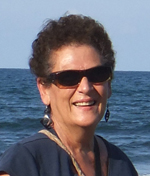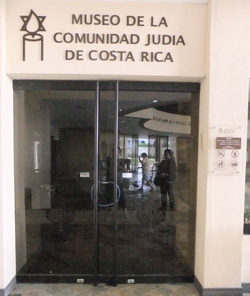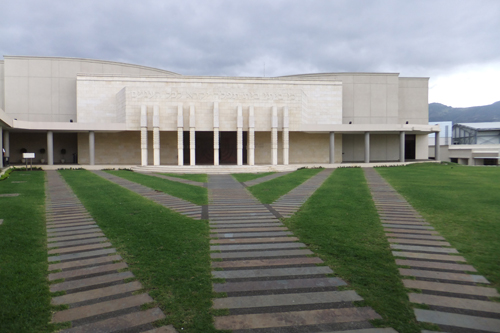Story and photos by Ilene Lerner

 SAN JOSE, Costa Rica — My Costa Rican friend and colleague, Rebecca Gueverra, and I went to visit the Jewish Museum here. I knew from research on the Internet, that there was a small Jewish community here of about 3,000 and wanted to connect with it. I had asked some people if they knew how I might do this, but got different, non-helpful answers, such as that there were no Jews in this country (which I knew to be untrue) or that the Jews were very rich and people had no idea how to find them. But when I told Rebecca about my wish, she responded, “Oh, there is a Jewish Museum in San Jose. I will find out how we can go there.”
SAN JOSE, Costa Rica — My Costa Rican friend and colleague, Rebecca Gueverra, and I went to visit the Jewish Museum here. I knew from research on the Internet, that there was a small Jewish community here of about 3,000 and wanted to connect with it. I had asked some people if they knew how I might do this, but got different, non-helpful answers, such as that there were no Jews in this country (which I knew to be untrue) or that the Jews were very rich and people had no idea how to find them. But when I told Rebecca about my wish, she responded, “Oh, there is a Jewish Museum in San Jose. I will find out how we can go there.”
I was so excited there was a Jewish Museum; I was certain that there I could learn what I wanted to know about the history of Jews in Costa Rica. But in order to get permission to visit, we had to fax our ID documents, in my case, a copy of my passport. Then we had to make an appointment with an employee of the museum who would give us a tour. On my last Monday in Costa Rica, April 23, Rebecca and I took a taxi there, coming to a part of San Jose I hadn’t seen before, more commercial and modern. Getting out of the taxi we were confronted by a large wall surrounding the Museum grounds and a big electric garage door. It was impossible to know what awaited us on the other side. I commented to Rebecca, as we looked for someone to open the door, that all the security was probably caused by the attacks on Jewish institutions around the world, most recently in France.
Not finding anyone to request an entrance, we were unsure what to do, but suddenly the black door began to rise and I surmised there must have been a security camera somewhere. We quickly passed through the unimpressive entrance and stood, surpised and impressed by the complex of beautiful buildings and grounds that we saw before us. I felt like Dorothy in The Wizard of Oz when she arrived at the Emerald City.
The stone synagogue occupied the central spot; it looked both modern and classical, with eight stone columns in the front, but not immediately appearing to support the roof. The building itself evoked the Jewish menorah, and in the lawn in front of the synagogue, another menorah appeared on the ground in the design of the slate paths leading from one part of the complex to another. The surrounding, sheltering mountains in the distance lent their power and importance to the scene and the white clouds above the peaks seemed to be the only thing moving.
Randall Zumbado, the director of the Museum, met and greeted us in the lobby area. He brought us into the museum, El Museo de la Comunidad Judio de Costa Rica. The museum occupied just one floor. As I looked around, I knew I wanted to share this with others so I asked Zumbado if I might take photos. Before he agreed, Zumbado wanted to know exactly who I was and why I wanted to visit the museum. I answered Zumbado that I was a Jewish woman from the U.S., who was teaching English in Costa Rica, and that I was interested in knowing more about the history of the Jews in Costa Rica. He asked me where my grandparents were from and I told him the Ukraine and Poland. I asked him if he were Jewish. “No soy Judio–I am not Jewish.” “Are you Jewish too?” he asked Rebecca, who explained that she was an English professor at Instituto Nacional de Aprendizaje (National Institute of Learning) whom I worked with, and that she had agreed to accompany me. Zumbado seemed convinced of our authenticity when he heard that my grandparents were from Poland. He smiled and said, “Now you may take photos.”
Although not Jewish, Zumbado proved to be very knowledgeable about the history and religion of the community. As he explained in Spanish (with Rebecca to translate if I failed to understand) we viewed one display of the Ten Commandments in Hebrew and in Spanish, an exhibit representing the ten tribes of Israel, and another about the history of Jewish immigration to Costa Rica. As we followed him around the museum, listening to all he had to tell us, an abundance of memories came to me of my early life when I lived ‘in the city’ (meaning the Bronx and the Williamsburg section of Brooklyn, N.Y.).
Zumbado stood next to the display on the wall, and pointed to it as he spoke. He said that there had been three waves of Jewish immigration: the first Jews in Costa Rica came with the arrival of Columbus/Colon. Zumbado said there were four Jews on board the ships carrying Christopher Columbus to the new world; the first person to spot land was a Jew. In the 15th and 16th century, some Sephardic Jews, fleeing the Inquisition made Costa Rica home.
After the Holocaust, a second group of 100 Jews landed in Limon, on the Caribbean coast, seeking refuge, where for the first time, they met Black people. According to the law, all immigrants were required to show that they had $25. The Jews arrived nearly penniless, but someone had $25, which, after being shown was passed to the next in line. Zumbado explained that the Customs Officials knew exactly what was going on, but allowed the Jews to enter because they understood that they were concentration camp survivors who needed a home.
The third wave of immigration occurred in the 1970’s as political and military repression swept Latin America; Jews fled to Costa Rica because it had no military, was a democracy, and, as Zumbado added, “for the Pura Vida!”
Later I discovered that in recent years, there have been a small, uncounted number of Jewish retirees settling here also.
So, how did the Jews achieve their prosperity in less than 70 years? An exhibit showed photos of men on horses who became known as Klappers, “because of the sound of their knocks on doors,” and Polacos because these ‘traveling salesmen’, “came from three towns in Poland”. Somehow these survivors obtained an inventory of household products, and on foot and on horseback they went door to door selling their wares, eventually accumulating capital, opening stores and becoming very successful! There was an old photo of a happy Jewish family working in their newly established store.
As we walked round the exhibits, viewing religious artifacts, such as an 18th Century Tanakh and a velvet-embroidered, ceremonial Huppah, under which Jewish couples married, Zumbado explained about the practice of keeping Kosher, the circumcision of Jewish males soon after birth, Jewish marriage and other rituals and holidays. After Zumbado talked about the concept of Kosher food (not mixing meat and milk dishes) I told them about the time I had mixed a fleishadich fork with a milchadich dish. I was just a little girl, probably not even four, but I remember exactly how my Zadie (Grandfather) abruptly stood up from the table where we were sitting, grabbed the contaminated fork and rushed out the apartment and down the stairway.
Alarmed by my Zadie’s rapid exit, I was about to cry, when my Bubbe (Grandmother) grabbed my arm and pulled me into my grandparents’ bedroom at the back of the apartment. We stood at the window looking down and saw my grandfather rush out of the building, go to the fence where he knelt, bend down on his knees and bury the offending fork in the dusty ground. Two weeks later, he dug it up, washed it of the dirt and the sin, and restored it to its place in a glass jar in the middle of the kitchen table. I felt relieved, as though when the fork was forgiven, so was I. But I still don’t understand how burying a profane fork in dirt could cleanse it!
Zumbado also claimed that the word bruja or witch arose “because the Jews had met in secret to practice their religion. Their prayers began with baruch, which got translated into Spanish as bruja or witch.” I thought how they must have feared the Inquisition and anti-Semitism.
I found a window ledge occupied by an open book and some old documents. I leaned over to see what they were and found to my great amazement, the page the book was open to had a photo of a young Jewish couple seated at a table, their eyes sad with the scarcely concealed knowledge that they were soon to be transported. I was astounded because this very picture is framed and has been on one of my bedroom walls for several years! And next to it, I was shocked to see, the Nazi stamped ID paper of a Jewish woman, whose first name I don’t remember, but whose last name was Wien!
Wien was my mother’s maiden name and is the last name of my uncles, their wives, sons and grandchildren. I stared at the photo wondering if this woman could be a relative of mine! The book was called, And I Still See Their Faces, a tribute to a lost town in Poland, most of whose residents died after being sent to concentration camps. I had seen the exhibit And I Still See Their Faces in Boston in the early 2000’s and bought the poster, which I framed, there.
As I stood staring at the photo of the tragic, lost couple and the Wien ID, I felt the sense of confusion and at the same time, crystal-clear clarity that always accompanies these sorts of coincidences in my life. I remembered how I had found my way to the old Jewish quarter in Seville, Spain, 20 years earlier. Without directions, but knowing that I knew the way, I had led my friend Evelyn directly into the Old Jewish Quarter. This felt as momentous as that discovery. The feeling that my whole trip and time in this country was made more meaningful by this find imbued me. When I recovered, and told Zumbado that Wien was my mother’s maiden name, he responded that the woman of the document was very old but still alive, and living in San Jose; it might be possible to meet her. I was very disappointed knowing this would not be possible to arrange in the short time I had left before returning home. I would have loved to meet and speak with the woman who bore the name Wien.
Before we left the museum, we entered a room containing relics of the Holocaust and a memorial wall of photos of some of its victims, relatives of the immigrants. In one glass display case we saw an actual yellow cloth star that one of the immigrants had been forced to wear and two bars of soap, made from human bodies. Rebecca and I watched a video taken by Nazi photographers of the dreadful conditions of the ghetto, of assaults on Jews, old and young, and we witnessed the sight of people dying in the streets from starvation while other people had to walk around those who had fallen without taking any notice. I stole a glance at Rebecca to see her reaction and one look at her normally cheerful face told me that she and I, Christian and Jew, a Costa Rican and a North American, were united in horror and grief for these suffering people, my people, her people.
Another video, recorded some years earlier, was of Costa Rican survivors being interviewed about their experiences during the Holocaust, showing the numbers branded on their arms, and the damage to their souls in the sound of their voices, the catches in their breath, the tears in their eyes as they recounted their terrible stories; from such experiences there is only partial recovery. Exiting the museum, I requested to see the magnificent synagogue, and as Rebecca, Zumbado and I walked toward it, we passed wall art honoring those who died in the camps, and also a magnificent sculpture in their name.
We stopped in a garden area that beckoned with the promise of peace and repose, and Rebecca took photographs of me there. It was lovely, and although from beyond the wall I could hear the sound of the city traffic, here, it was green and peaceful. Zumbado told us that the eight stone pillars in front of the large Orthodox synagogue symbolized the lights of the menorah. It was obvious the most careful planning had gone into the building of this remarkable synagogue, built by a people who had traveled far and suffered much. Unfortunately, the synagogue was locked, so we weren’t able to see inside, but I could imagine how it might look from others I had seen. It was ironic that despite my Jewish birth and family, I could only read the Spanish written on the walls and not the Hebrew, for I was not taught Hebrew. My stepfather thought ‘religion was the opiate of the people’.
There was a smaller synagogue close by, of which the door was open, and as I looked in I could see two Jewish scholars studying and discussing the Torah. Neither was a female, not surprising in an Orthodox synagogue. I requested to see the senior center, and we moved back, to the left of the big synagogue, to another building; in there I could see a meeting of older women taking place, women who looked to be in their 70’s and 80’s. I had a strong desire to go in and meet them for they made me think about my mother and my aunts, who are gone now, but Rebecca needed to see her cousin to tutor him in English, so as they turned to see who was looking in on them with such interest, I merely had time to blow them a kiss before leaving. I resolved to try to make that connection the next time I visit Costa Rica.
Before we left, we stopped in the cozy café and I bought chocolate brownies for Rebecca, Zumbado and me. They were so delicious and seemed a sweet reward after witnessing the bitterness of Jewish life! I reflected that though the day had echoed the joke about all Jewish holidays that I had told Rebecca earlier: “They tried to kill us; we survived; Let’s eat!”
The next day in class Rebecca and I told the students about our visit to the Museum. Rebecca remarked how much she had learned. “You should all visit,” she advised.
*
Lerner is a freelance writer based in Cambridge, Massachusetts. She may be contacted at ilene.lerner@sdjewishworld.com

Pingback: Museum explores 3 waves of Jewish immigration to Costa Rica – San Diego Jewish World « Costa Rica Vacation